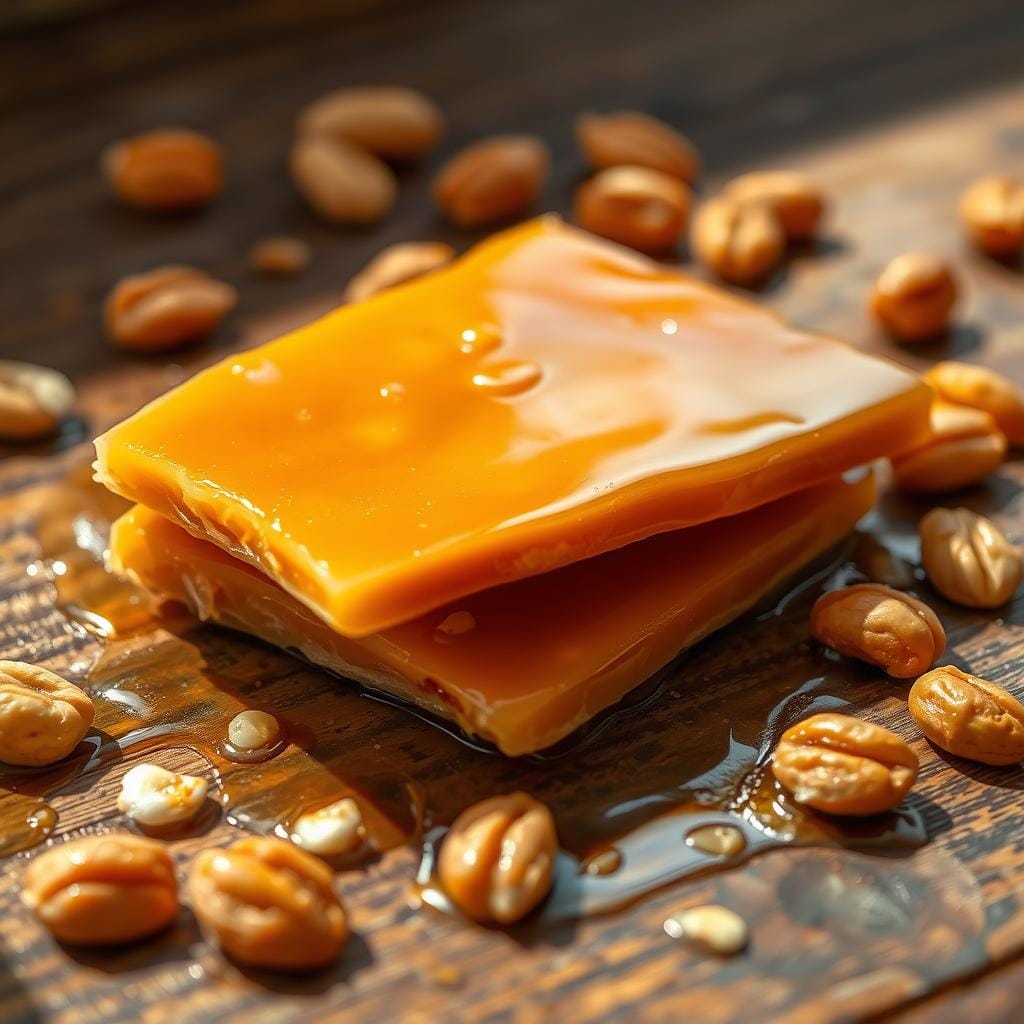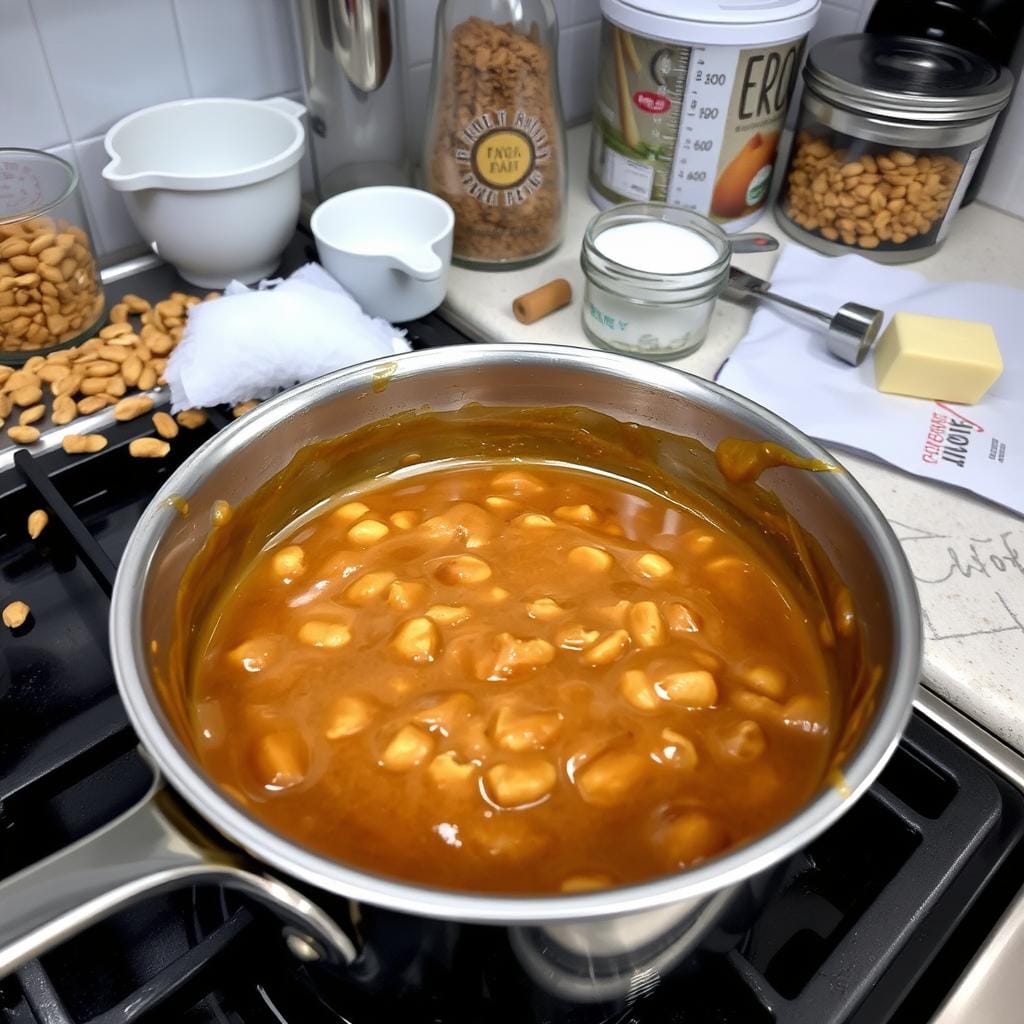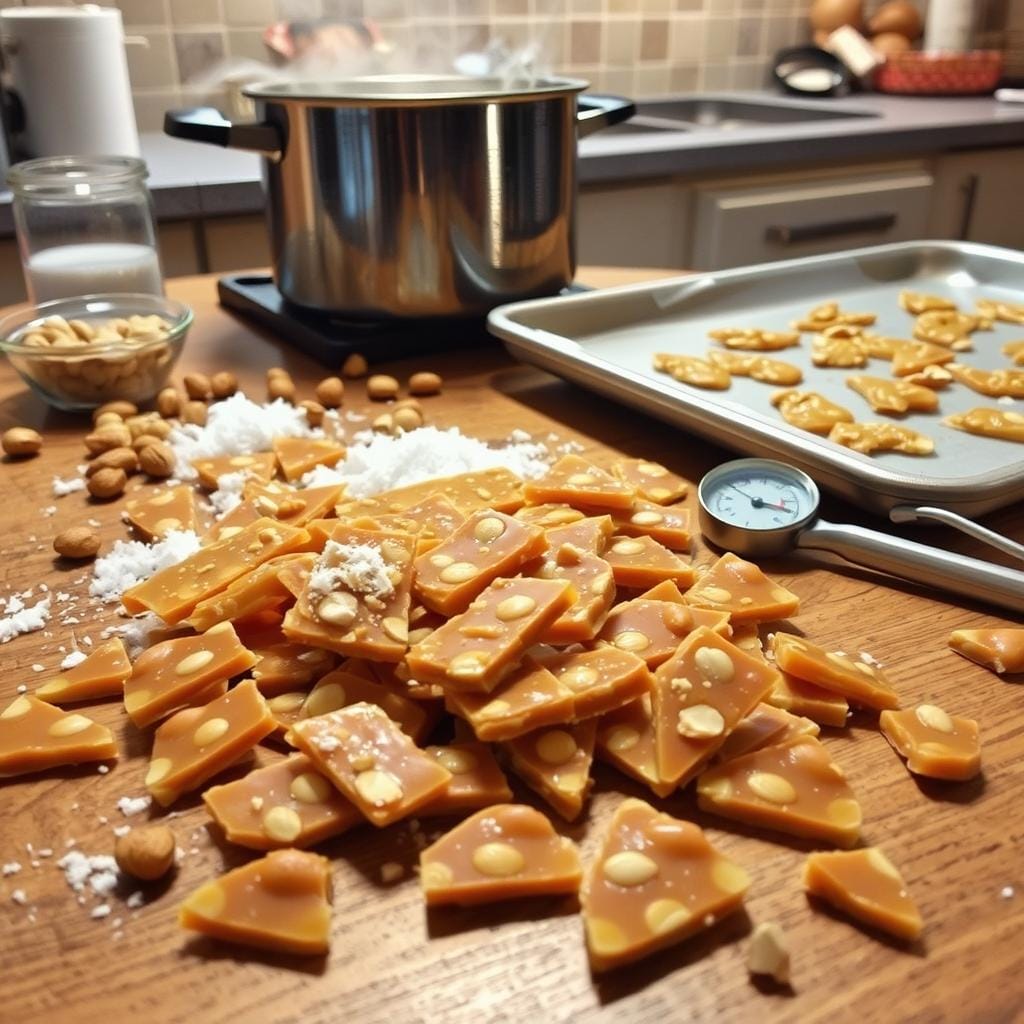Imagine the excitement of bringing your homemade peanut brittle to a gathering. But, it refuses to harden. You glance around, hoping for a miracle, as friends and family eagerly await a taste. It can be disheartening to face the question: why is my peanut brittle not getting hard? Understanding the essential factors that influence peanut brittle troubleshooting is key to achieving the perfect crunch.
Whether you’re a seasoned pro or just starting your journey in confectionery, encountering peanut brittle recipe problems can evoke feelings of frustration. However, each setback offers a valuable lesson to ensure your next batch stands tall with that satisfying crack. In this section, we’ll explore the critical reasons your peanut brittle may not be hardening, paving the way for you to become the expert you aspire to be. Let’s turn that soft slab into a deliciously crunchy experience!
Key Takeaways
- Understanding the importance of temperature for hardening peanut brittle.
- Identifying common ingredients that can affect consistency.
- The role of sugar chemistry in achieving the right texture.
- Evaluating cooking times to prevent over and undercooking.
- Recognizing how humidity can impact your candy’s outcome.
Understanding Peanut Brittle Consistency
To get the perfect peanut brittle, you need to balance a few key things. It’s all about making that crunchy treat you love. The journey starts with sugar changing when it’s heated. This change is what makes the candy hard.
What Makes Peanut Brittle Hard?
The hardness of brittle comes from sugar bonding when it caramelizes. When you heat sugar, it melts and hits a hardening point when it cools. This step is crucial for making peanut brittle right, as undercooked sugar makes it chewy or sticky.
The main factors for hardening are:
- Heating sugar to the right temperature (around 300°F or 149°C).
- Letting the mixture cool well before breaking it apart.
- Adding corn syrup to stop crystals from forming.
Common Ingredients in Peanut Brittle
Some ingredients are key in making brittle. Each one is important for that crunchy feel. The main ingredients are:
- Peanuts: They add flavor and texture.
- Sugar: It’s the main sweetener that gets hard when caramelized.
- Corn syrup: It helps get the right texture and stops crystals.
- Butter or margarine: They add richness and flavor.

Why is My Peanut Brittle Not Getting Hard?
When your peanut doesn’t harden, it’s often because of temperature and candy making basics. Sugar’s role in cooking is also key. To figure out why, we need to look at these important factors.
Temperature and Its Impact on Hardening
Getting the right temperature is crucial in candy making. For brittle, you need to hit the hard crack stage, between 300°F to 310°F. If it’s too low, the sugar won’t caramelize right, making the texture bad. Use a candy thermometer for accurate readings.
Understanding Sugar Chemistry
Sugar chemistry is essential in making candies. Sugar changes a lot when heated. It can either form crystals or caramelize, based on the heat and method used. Crystals make it grainy, but caramelization gives it the hardness and taste we want.
For more on the differences between candies, check out this source: difference between toffee and peanut brittle.

Troubleshooting Peanut Brittle Issues
Making perfect brittle needs careful thought. You must check your cooking temperature and timing. These steps help you get the crunchy texture you want.
Examining Your Cooking Temperature
The cooking temperature is key. If it’s too low, the sugar won’t set right, making it soft. Too high, and it burns, ruining the taste. Use a candy thermometer to aim for 300°F to 310°F.
Importance of Timing in Candy Making
Timing is crucial for great peanut. Let the mixture thicken well before cooling. Rushing can make it sticky. Also, cool it fully before cutting to avoid problems.
Candy Making Issues to Consider
Making peanut brittle can be tricky. You need to watch out for humidity and the right equipment. These factors can greatly affect your candy’s taste and texture.
Humidity and Its Effect on Candy Consistency
High humidity can mess up your candy. Sugar absorbs moisture from the air, making your brittle soft. Here’s how to deal with it:
- Check the weather before you start.
- Try to make candy on dry days.
- If it’s humid, adjust your cooking time and temperature.
Wrong Equipment Can Spoil Your Batch
The right tools are key for good brittle. Wrong equipment can burn or cook unevenly. Here’s what to think about for equipment for making peanut brittle:
- Get a good candy thermometer for accurate readings.
- Choose heavy pans for even heat.
- Don’t use non-stick pans for the traditional texture.
Common Peanut Brittle Recipe Problems
Making peanut brittle can be fun, but it can also have its challenges. Knowing how to fix common problems is key to getting it just right.
Using the Right Ingredients
Choosing the right ingredients is crucial for brittle. You need fresh, high-quality peanuts, sugar, and corn syrup. These ingredients affect the taste and texture of your candy.
Using old peanuts or low-quality sugar can ruin your candy. Always pick the best ingredients for the best results.
How Overcooking Can Ruin Your Brittle
Overcooking can mess up your brittle. If it’s cooked too long, it can taste burnt. This can make the candy taste bad.
It’s important to cook it at the right temperature. Watch your candy closely while it cooks. This way, you can avoid overcooking and make perfect candy.
How to Fix Soft Peanut Brittle
Dealing with soft peanut brittle can be a challenge. But, there are steps you can take to fix it. Understanding temperature and timing is key. Also, knowing how to improve the candy’s texture is crucial.
Re-melting and Repeating the Process
Re-melting is a good first step. Break the soft brittle into smaller pieces and put them in a saucepan. Heat them over low to medium heat, stirring often.
Watch the temperature to prevent burning the sugar. As it melts, check the consistency. Pour it onto a baking sheet and let it cool completely.
Adding Ingredients to Adjust Texture
Adding ingredients can help improve the texture. A bit more granulated sugar or corn syrup can make it crunchier. These ingredients sweeten it and add crunch.
Mix well and let it set. This ensures it hardens to the right consistency.
Tips for Making Perfect Peanut Brittle
Making perfect brittle needs focus and careful steps. Following the recipe closely is key. Cooling the brittle right is also crucial for the right texture.
Thoroughly Follow the Recipe Steps
Stick to the recipe for the best results. Each ingredient and step is important. Here are some tips:
- Measure ingredients accurately to maintain the correct ratio of sugar to peanuts.
- Use a candy thermometer to check the temperature precisely, avoiding overcooking or undercooking.
- Stir carefully at designated intervals, ensuring that sugar dissolves evenly without crystallization.
Ensuring Proper Cooling Time
Cooling the brittle right is key for its hardness. Here’s what to do after pouring the hot mixture onto a baking sheet:
- Let the brittle sit undisturbed for at least two hours to cool completely.
- Place the baking sheet in a draft-free area to avoid moisture affecting the candy.
- For quicker results, use a fan to circulate air around the brittle, ensuring even cooling without rushing the process.
By following these tips, you can make delicious peanut brittle. Knowing the importance of precise steps and cooling techniques will make your treats a hit with everyone.
Peanut Brittle Troubleshooting Checklist
This peanut brittle troubleshooting checklist is here to help you make the best peanut brittle. It covers the most important things to think about when making candy. Follow these steps if you run into problems to make your candy-making journey smoother.
Quick Recap of Key Factors
- Temperature: Use a candy thermometer to keep an eye on the syrup. It should be around 300°F for perfect peanut brittle.
- Timing: Watch how long you cook it. Too long and it’s overcooked, too short and it’s chewy.
- Humidity: Make candy on dry days for the best crunch. High humidity can mess with the hardening process.
- Ingredient Quality: Choose fresh peanuts and good sugar for the best taste and texture.
Final Thoughts on Achieving the Perfect Crunch
By following these tips, you can get your peanut just right. Keep this checklist handy for help. With practice and attention, you’ll get great results from your candy-making.
| Factor | Optimal Condition | Common Mistakes |
|---|---|---|
| Temperature | 300°F | Cooking above or below recommended temperature |
| Timing | Monitor closely | Getting distracted while cooking |
| Humidity | Low humidity | Making candy on rainy or humid days |
| Ingredient Quality | Fresh and high-quality products | Using stale or inferior ingredients |
Conclusion
As we wrap up this peanut brittle guide, it’s important to remember why your treat might not harden. We’ve talked about temperature, timing, and ingredient quality. These are key to making perfect peanut brittle every time.
Remember, practice makes perfect. The more you make candy, the better you’ll get. This is crucial for achieving the perfect peanut brittle.
This guide has shown you how to fix common problems. It turns a soft, sticky batch into a crunchy delight. Don’t be afraid to try new recipes and techniques. It’s all about creativity in candy making.
With patience and attention to detail, you’ll soon be a pro at making peanut brittle. It will not only harden but also impress everyone who tries it. So, get your ingredients ready and start making something special.

